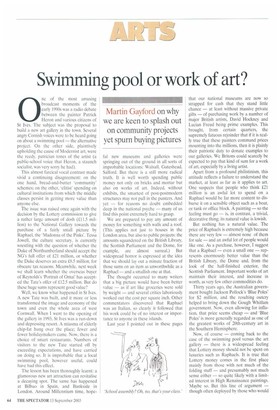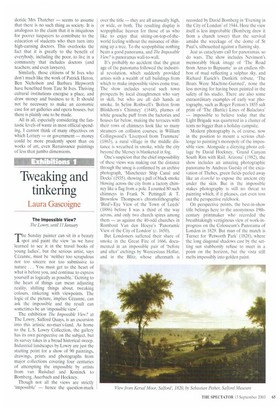Swimming pool or work of art?
Martin Gayford on why we are keen to splash out on community projects yet spurn buying pictures
0 ne of the most amusing broadcast moments of the early 1990s was a radio debate between the painter Patrick Heron and various citizens of St Ives. The subject was the proposal to build a new art gallery in the town. Several angry Cornish voices were to be heard going on about a swimming pool — the alternative project. On the other side, plaintively upholding the cause of Modernist art, were the reedy, patrician tones of the artist (a public-school voice that Heron, a staunch socialist, was very sorry he had).
This almost farcical vocal contrast made vivid a continuing disagreement: on the one hand, bread-and-butter 'community' schemes; on the other, 'elitist spending on cultural institutions from which the middle classes persist in getting more value than anyone else.
The issue was raised once again with the decision by the Lottery commission to give a rather large amount of dosh (£11.5 million) to the National Gallery towards the purchase of a fairly small picture by Raphael, the 'Madonna of the Pinks'. Tessa Jowell, the culture secretary. is currently wrestling with the question of whether the Duke of Northumberland should accept the NG's full offer of £21 million, or whether the Duke deserves an extra £8.5 million, for obscure tax reasons. Meanwhile, next week we shall learn whether the overseas buyer of Reynolds's 'Portrait of Omai' has accepted the Tate's offer of £12.5 million. But do these huge sums represent good value?
Well, we know what happened in St Ives. A new Tate was built, and it more or less transformed the image and economy of the town and even the whole area of west Cornwall. When I went to the opening of the gallery in 1993, St Ives was a run-down and depressing resort. A miasma of elderly chip-fat hung over the place; fewer and fewer holidaymakers came. Now, there is a choice of smart restaurants. Numbers of visitors to the new Tate started off by exceeding expectations, and have carried on doing so. It is improbable that a local swimming pool, however useful, could have had this effect.
The lesson has been thoroughly learnt: a glamorous new art attraction can revitalise a decaying spot. The same has happened at Bilbao in Spain. and Bankside in London. Around Millennium time, hope ful new museums and galleries were springing out of the ground in all sorts of improbable locations: Walsall, Gateshead, Salford. But there is a still more radical truth. It is well worth spending public money not only on bricks and mortar but also on works of art. Indeed, without exhibits, the smartest of post-postmodern structures may not pull in the punters. And yet — for reasons no doubt embedded deep in the national psyche — many of us find this point extremely hard to grasp.
We are prepared to pay any amount of money for something with walls and a roof. (This applies not just to houses in the London area, but also to public projects: the amounts squandered on the British Library, the Scottish Parliament and the Dome, for example, are almost surreal.) But widespread horror is expressed at the idea that we should lay out a minute fraction of those sums on an item as unworthwhile as a Raphael — and a smallish one at that.
The thought occurred to many writers that a big picture would have been better value — as if art like groceries were sold by weight — and several critics laboriously worked out the cost per square inch. Other commentators discovered that Raphael was an Italian, so clearly it followed that his work could be of no interest or importance to anyone in these islands.
Last year I pointed out in these pages that our national museums are now so strapped for cash that they stand little chance — at least without massive private gifts — of purchasing work by a number of major British artists, David Hockney and Lucian Freud being prime examples. This brought, from certain quarters, the supremely fatuous rejoinder that if it is really true that these painters command prices mounting into the millions, then it is plainly their patriotic duty to donate examples to our galleries. We Britons could scarcely be expected to pay that kind of sum for a work of art, especially by a living artist.
Apart from a profound philistinism, this attitude reflects a failure to understand the market, at least as far as it applies to art. One suspects that people who think £21 million is an awful lot to spend on a Raphael would be far more content to disburse it on a sensible object such as a boat, or tank or office block. A painting — so the feeling must go — is, in contrast, a trivial, decorative thing; its natural value is lowish.
But nothing has a natural value. The price of Raphaels is extremely high because there are very few — almost none of them for sale — and an awful lot of people would like one. As a purchase, however, I suggest that a Raphael — even a small one — represents enormously better value than the British Library, the Dome and, from the look of the half-finished exterior, the Scottish Parliament. Important works of art maintain their interest, and increase in worth, as very few other commodities do.
Thirty years ago, the Australian government bought Jackson Pollock's 'Blue Poles' for $2 million, and the resulting outcry helped to bring down the Gough Whitlam government. Now, even allowing for inflation, that price seems cheap — and 'Blue Poles' is more generally regarded as one of the greatest works of 20th-century art in the Southern Hemisphere.
Now, of course — coming back to the case of the swimming pool versus the art gallery — there is a widespread feeling that Lottery money should not be spent on luxuries such as Raphaels. It is true that Lottery money comes in the first place mainly from those with not much of the folding stuff — and presumably not much sense either — so quite likely with a limited interest in High Renaissance paintings. Maybe so. But this line of argument — though often deployed by those who would deride Mrs Thatcher — seems to assume that there is no such thing as society. It is analogous to the claim that it is iniquitous for poorer taxpayers to contribute to the education of students who then turn into high-earning doctors. This overlooks the fact that it is greatly to the benefit of everybody, including the poor, to live in a community that includes doctors (and teachers, and even lawyers).
Similarly, those citizens of St Ives who don't much like the work of Patrick Heron, Ben Nicholson and Barbara Hepworth have benefited from Tate St Ives. Thriving cultural institutions energise a place, and draw money and business to it. It should not be necessary to make an economic case for art galleries and opera houses, but there is plainly one to be made.
All in all. especially considering the fantastic levels of waste in most official spending, I cannot think of many objectives on which Lottery — or government — money could be more prudently spent than on works of art, even Renaissance paintings of less than jumbo dimensions.



























































































 Previous page
Previous page